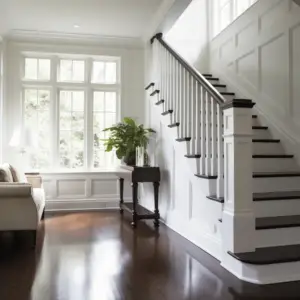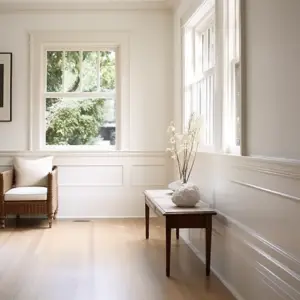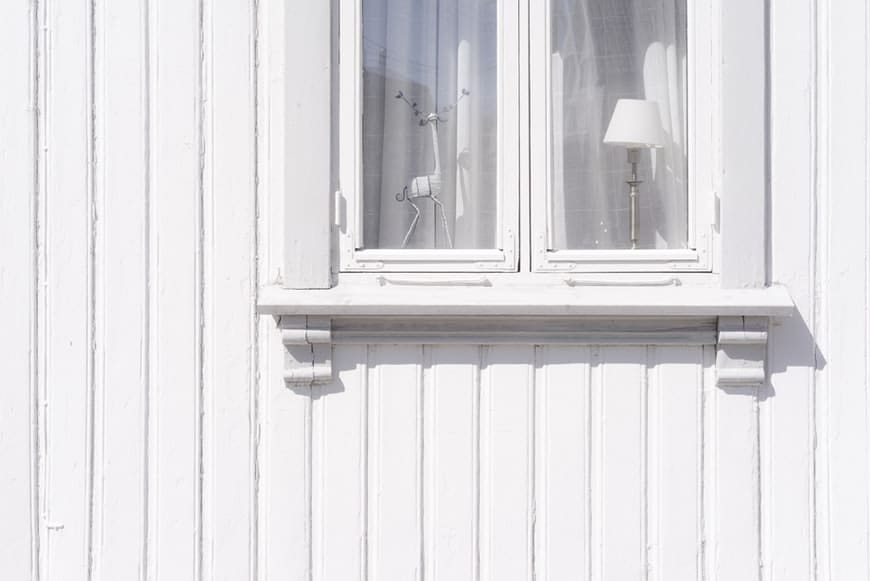It’s usually a big deal to paint a house. If you’re thinking about painting your wood trim white, double-check that it’s the ideal option for you.
Even though each home is unique, there are a few things to consider before painting your home.
In most cases, you should paint your wood trim white. This will make your little room appear more modern, tidy, and spacious.
However, if your walls are already painted white, you should avoid using white and instead use other shades (such as cream, light brown, or off-white) that suit your room decor.
We’ll go through the benefits and drawbacks of painting your finished wood trim white in this article so that you can make the best decision for yourself.
Table of Contents
The Pros and Cons of Painting Your Wood Trim White

Painting your wood trim white has ups and downs, just like anything else in life. In many circumstances, your style and design preferences are the determining factors.
Even yet, knowing the advantages and disadvantages before making that final decision is always a brilliant idea.
Pros
White Trim Make You Home to Look More Modern
Modernity is a highly appreciated trait in today’s homes. The white trim adds a touch of modernism. It has a new quality to it, which translates to how your guests see a room.
As a result, white trim can be very handy in an older home. Maintaining major areas of stained woodwork in an older home while painting the trim white gives a unique and appealing variety.
This may result in a style that can’t be replicated in a modern home.
It’s Simple to Keep White Trim Clean
Despite popular belief, cleaning white trim isn’t all that difficult. There are various fast solutions available depending on how scuffed your trimmings become.
Any blemishes can easily be removed with Mr. Clean Magic Erasers, wet cleaning wipes, or Swiffers.
Even if your white trim needs a deep clean, a dry wipe accompanied by a warm, soapy washcloth will do the job.
Additionally, glossy white trims are often painted with a satin, semi-gloss, or even high-gloss finish. Typically, the shinier finishes are usually easier to clean.
Your Room Will be Brightened by Reflective Surfaces
In human eyes, white mirrors the color spectrum. As a result, you can utilize it to bring out the colors in your room.
White trim ensures a beneficial contribution to the overall ambiance of your living space while seeking to accentuate a colored wall. Let’s use the color gray as an example.
Gray, if left alone, has a dull aspect, which may give your visitors an unfavorable impression.
Adding white trim to a gray space, on the other hand, produces a pleasing contrast.
The contrast heightens the contrast between the two hues and intensifies the gray. That’s just white trim reflecting off a gray wall.
The visual effect of juxtaposing white trim with brighter colors can be even more pleasing.
Additionally, white trim also complements a variety of wall patterns and lighter wallpapers.
Your Space Will Appear Larger With White Trim
In most cases, adding a bit of white to a room makes it appear large. This is owing to the widening effect that white has on the human eye.
Have you heard that wearing white clothes can make you appear bigger while wearing black clothing will slim you down? This is the same principle we’re using in your home right now.
As a result, white trims can make a space look bigger, especially smaller ones. Instead of making a person feel hemmed in, it might provide the impression of more space.
The added touch of white will give the occupant a more enormous, more welcoming impression.
White Trim Makes Our Home To Appear Clean
Because white is associated with cleanliness and purity, white trim conveys a sense of cleanliness.
Have you ever noticed that every doctor’s office you’ve visited is so white? Now you’re aware.
Sure, you don’t want your home to look so sterile that your visitors think they’ve walked into a clinic.
However, painting your trim white conveys a sense of cleanliness. And, let’s face it, even when it isn’t, we always want our homes to appear clean.
The white trim adds a sense of tranquility to the room
The color white has a relaxing effect. Painting your wood trim white gives a more balanced and serene appeal since it serves as a visual foundation for your room.
As a result, white trim looks fantastic in family meeting rooms, home offices, and libraries. You can’t choose your family, but your freshly painted white trim might help them relax a little.
Cons
White Trims Don’t Match Well With White Walls
If your room’s walls are already painted white, white trim isn’t the ideal choice.
Remember how white walls indicate sterility in clinics? Unless you want a white-on-white color scheme that makes your room look like a doctor’s office, white trim isn’t the best bet in this case.
Painting Your Trims White Covers the Naturally-Beautiful Wood
Painting your wood trims white could be a huge no-no if you have an old home.
This is since older homes often feature a lovely natural wood design that is appealing and uncommon in newer buildings. As a result, painting over your wood trim may detract from the elegance of your home in ways you can’t undo.
Potentially Reduces The Resale Value of Your House

Another disadvantage of painting your wood trim white is that it may subtract from your home’s selling value.
If you plan to sell your property in the future, you could be better off just leaving it alone.
This will allow you to keep your home’s historic appeal while leaving the difficult decisions to a future buyer.
Even if you don’t want to sell your house, it’s a good idea to leave your personality open because you never know what you’ll do next.
Conclusion
Wooden trims aren’t a thing of the past. They are used in many new homes since they are a more durable and cost-effective solution. However, whether you leave your wood trim natural or paint it white is entirely up to you.
The practice has pros and cons; however, many of the negatives are experienced by those who own historic or architecturally appealing homes. As a result, painting your natural wood trim white may not have many negative implications.


